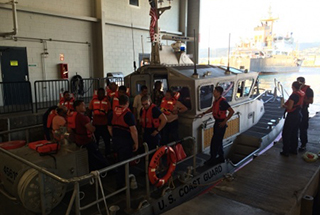A captain’s decision to set out for a sea trial with an unsecured hull opening near the stern brought on the Jan. 22 of a towing vessel off Oahu, the National Transportation Safety Board said in a report issued this week.
The 95’x34’x17’ towing vessel Nalani, owned by Vogel Equipment, San Francisco, and operated by Remolcadores de Altura S.A. of Chile, had been re-flagged from U.S. to Panamanian registry in 2014 and was being prepared in Hawaii for work in Panama. On the morning before the scheduled sea trial at the Marisco Shipyard west of Honolulu, an owner’s representative had directed a shipyard worker to cut out a 20-inch-diameter welded steel plate cover from the starboard side of the stern deck above the starboard aft peak tank, NTSB investigators reported.
“Steel plates had been welded in place of bolted hatch covers the previous year due to water leakage into the aft peak tanks,” the report said. The shipyard worker was told to replace the 20-inch plate with a raised-combing hatch cover, with threaded bolts for securing. But when the worker returned around 2:35 p.m. to finish the job, he found the Nalani had left the dock, the report said.
About a week before the boat’s autopilot system had failed. After repairs a 30-minute sea trial was planned that afternoon to test the system, on the day before the Nalani was to depart Hawaii.
“The crew on board the vessel temporarily placed a piece of gasket material over the 20-inch hole in place of the steel cover. This remedy, however, left the starboard aft peak tank vulnerable to water intrusion and progressive downflooding,” the NTSB report said. “The captain told investigators that he was aware of the unsecured opening but decided to get under way for the sea trial anyway.”
On board were 11 people, including the Panamanian crew, a state pilot, two owners’ representatives and the technician who had fixed the autopilot. As the boat made its transit and the system was being tested, the sea state and low freeboard contributed to water sloshing over the stern and down the starboard tank opening. The pilot realized there was flooding, and the captain reduced speed and made a long, 180-degree port turn back to harbor, the report said.
But swells began coming over the stern and flooding increased. At 3:13 p.m. the pilot put a distress call to the Coast Guard on VHF channel 16. Within minutes the vessel began listing heavily to port, the captain sounded the general alarm, and the pilot instructed everyone to move to the high side of the vessel and abandon ship. The Nalani soon sank in 2,200’ of water.
The Coast Guard dispatched a 45’ medium response boat and 110’ cutter. First on the scene were a National Oceanic and Atmospheric Administration patrol boat, the tugboat Tiger 5, and the Clean Islands, an oil spill response vessel. All 11 people were rescued without injury.
As part of the investigation, Coast Guard experts made a stability analysis of the Nalani and reported the vessel would have met U.S. standards for stability, had the starboard deck opening been sealed.
“The National Transportation Safety Board determines that the probable cause of the flooding and eventual sinking of the Nalani was the captain’s decision to get under way without sufficient freeboard at the stern and without ensuring proper watertight integrity,” the NTSB concluded.





